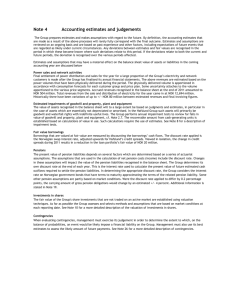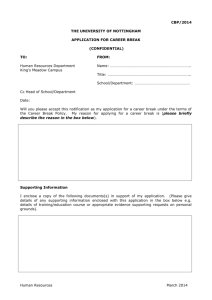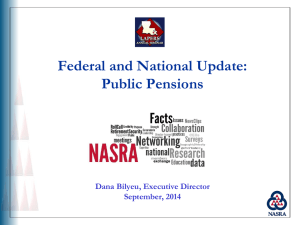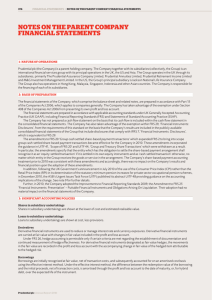Pension fund equity investment
advertisement
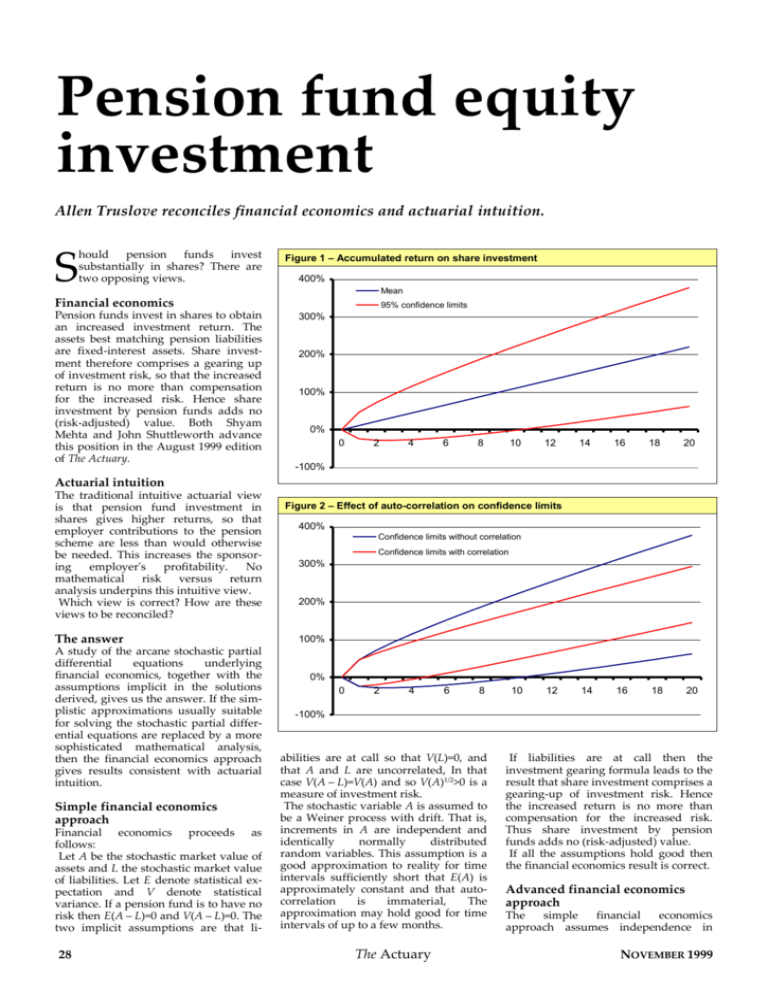
Pension fund equity investment Allen Truslove reconciles financial economics and actuarial intuition. hould pension funds invest substantially in shares? There are two opposing views. S Figure 1 – Accumulated return on share investment 400% Mean Financial economics Pension funds invest in shares to obtain an increased investment return. The assets best matching pension liabilities are fixed-interest assets. Share investment therefore comprises a gearing up of investment risk, so that the increased return is no more than compensation for the increased risk. Hence share investment by pension funds adds no (risk-adjusted) value. Both Shyam Mehta and John Shuttleworth advance this position in the August 1999 edition of The Actuary. 95% confidence limits 300% 200% 100% 0% 0 2 4 6 8 10 12 14 16 18 20 14 16 18 20 -100% Actuarial intuition The traditional intuitive actuarial view is that pension fund investment in shares gives higher returns, so that employer contributions to the pension scheme are less than would otherwise be needed. This increases the sponsoring employer's profitability. No mathematical risk versus return analysis underpins this intuitive view. Which view is correct? How are these views to be reconciled? The answer A study of the arcane stochastic partial differential equations underlying financial economics, together with the assumptions implicit in the solutions derived, gives us the answer. If the simplistic approximations usually suitable for solving the stochastic partial differential equations are replaced by a more sophisticated mathematical analysis, then the financial economics approach gives results consistent with actuarial intuition. Simple financial economics approach Financial economics proceeds as follows: Let A be the stochastic market value of assets and L the stochastic market value of liabilities. Let E denote statistical expectation and V denote statistical variance. If a pension fund is to have no risk then E(A – L)=0 and V(A – L)=0. The two implicit assumptions are that li- 28 Figure 2 – Effect of auto-correlation on confidence limits 400% Confidence limits without correlation Confidence limits with correlation 300% 200% 100% 0% 0 2 4 6 8 10 12 -100% abilities are at call so that V(L)=0, and that A and L are uncorrelated, In that case V(A – L)=V(A) and so V(A)1/2>0 is a measure of investment risk. The stochastic variable A is assumed to be a Weiner process with drift. That is, increments in A are independent and identically normally distributed random variables. This assumption is a good approximation to reality for time intervals sufficiently short that E(A) is approximately constant and that autocorrelation is immaterial, The approximation may hold good for time intervals of up to a few months. The Actuary If liabilities are at call then the investment gearing formula leads to the result that share investment comprises a gearing-up of investment risk. Hence the increased return is no more than compensation for the increased risk. Thus share investment by pension funds adds no (risk-adjusted) value. If all the assumptions hold good then the financial economics result is correct. Advanced financial economics approach The simple financial economics approach assumes independence in NOVEMBER 1999 successive instants of time of the stochastic process governing A. This gives a 95% confidence interval over time for accumulated investment retuns as shown in Figure 1 However A is observed to exhibit auto-correlation. Auto-correlation is evident because the standard deviation of investment returns increases over time is less than t1/2V(A)1/2. This autocorrelated process may be modelled stochastically. A comparison of the 95% confidence intervals for investment returns with and without auto-correlation is shown in Figure 2. The result is that as t increases the standard deviation of the average return over t years decreases towards an asymptotic limit. Figure 3 shows the modelled and observed results for Australia’s ASX All Ordinaries share accumulation index. The consequence is that the investment risk measure V(A)1/2 needs to be that calculated for the time horizon t years under consideration. For liabilities at call (t=0 for example) the simple financial economics results are obtained. For longer-term liabilities the risk measure V(A)1/2 over t years is clearly less. Application to pension funds Pension fund liabilities comprise a sequence of payments extending many years into the future. Such liabilities are not at call. Auto-correlation of share investment returns over such long periods invalidates the assumptions underlying the simple financial economics approach. If pension payments are to be made with, say, 97.5% probability then for share investments the decreasing standard deviation with increasing term should be taken into account. The optimum asset versus liability matching investment strategy is then investment in assets, either fixed interest or shares, giving the higher yield for each term at which a pension payment is due. Figure 4 shows that at any given time the optimum matching strategy is fixedinterest investment for the earlier parts of the pension term and share investment for the later parts of the term. The significant issue is that without autocorrelation the lower bound for the share return would be below the fixedinterest return, whereas with autocorrelation the lower bound on the share return lies above the fixed-interest return. The boxed line gives the expected NOVEMBER 1999 Figure 3 – Average per year standard deviation 20% Observed correlated standard deviation Fitted correlated standard deviation 15% 10% 5% 0% 0 2 4 6 8 10 12 14 16 18 Figure 4 – Accumulated return 300% 250% 200% 150% 100% 50% 0% 0 2 4 6 8 10 12 14 16 18 20 -50% return from a diversified portfolio of shares. The dashed lines give the likely upper and lower limits above and below the expected return on shares. The unbroken lower line gives the expected return on fixed-interest securities. Justification The conceptual basis is that risk is always relative to the liabilities, When the liabilities are of long duration the relative risk differs from that when the liabilities are at call, The difference arises from the auto-correlation of share returns, This factor is neglected in the simple financial economics approach. The advanced financial economics model, allowing for the auto-correlated standard deviation in share returns over the term of a pension, produces a lower The Actuary average standard deviation over the term of the pension than the standard deviation applicable to liabilities at call. This difference is the justification for investment in shares. Actuarial intuition thus has a rigorous mathematical basis, even if not well understood! Interestingly, if pension funds should become more dominant as investors, the equity risk premium as currently measured may be expected to decrease. This would follow from a change in the average liabilities relative to which market risk is measured. Allen Truslove is a director at Cumpston Sarjeant, Actuaries & Statisticians. 29
